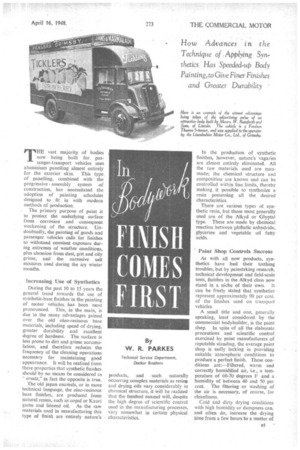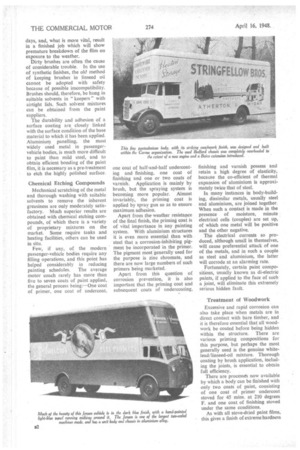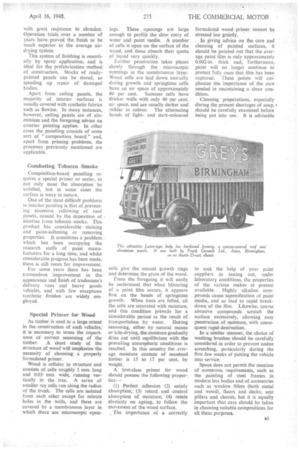FINISH COMES FIRST
Page 35

Page 36

Page 37

If you've noticed an error in this article please click here to report it so we can fix it.
By W. R. PARKES
THE vast majority of bodies now being built for, passenger-transport vehicles uses aluminium panelling almost entirely for the exterior skin. This type_ of panelling, combined with the progressive assembly system of construction, has necessitated the adoption of painting schedules designed to fit in with modern methods of production.
The primary purpose of paint is to protect the underlying surface from corrosion and consequent weakening of the structure. Undoubtedly, the painting of goods and passenger vehicles calls for finishes to withstand constant exposure during extremes of weather conditions, plus abrasion from dust, grit and city grime, and the corrosive salt mixtures used during the icy winter months.
Increasing Use eif Synthetics
During the past 10 to 15 years the general trend towards the use of synthetic-base finishes in the painting of motor vehicle& has been most pronounced, This, in the main, is due to the many advantages gained over the old oleo-resinous base materials, including speed of drying, greater durability and excellent degree of hardness. The surface is less prone to dirt and grime accumulation, and therefore reduces the frequency of the cleaning operations necessary for maintaining good appearance, It will be realized from these properties that synthetic finishes should by no means be considered as ersatz," in fact the opposite is true.
The old japan enamels, or in more technical language, the oleo-resinous base finishes, are produced from natural resins, such as copal or Kauri gums and linseed oil. As the raw materials used in manufacturing this type of finish are entirely nature's products, and such naturally occurring complex materials as resits and drying oils vary considerably in .chemical structure, it will be realized that the finished enamel will, despite the high degree of scientific control used in the manufacturing processes, vary somewhat in certain physical characteristics. In the production of synthetic finishes, however, nature's vagaries are almost entirely eliminated. All the raw materials used are manmade; the chemical structure and composition are known and can be controlled within fine limits, thereby making it passible to synthesize a resin possessing all the desired characteristics.
There are 'various types of synthetic resin, but those most generally used are of the Alkyd or Glyptal type. These are made by chemical reaction between phthalic anhydride, glycerine and vegetable oil fatly acids.
• Paint Shop Controls Success
As with all new products, synthetics have had their teething troubles, but by painstaking research, technical development and lield-scale tests, finishes in the Alkyd class now stand in a niche of their own. It can be freely stated that synthetics represent approximately 90 per cent. of the finishes used on transport vehicles.
A small title and one, generally speaking, least considered by the commercial bodybuilder, is the paint shop_ In spite of all the elaborate precautions and scientific control exercised by paint manufacturers of reputable standing, the average paint shop is sadly lacking in providing suitable atmospheric conditions to produce a perfect finish. These conditions are:—Filtered, warm and correctly humidified air, i.e, a temperature of 60-70 degrees F and a humidity of between 40 and 50 per cent. The filtering-or washing of the air is necessary, of course, for cleanliness.
Cold and dirty drying conditions with high humidity or dampness can, and often do, increase the drying time from a few tours to a matter of days, and, what is more vital, result in a finished job which will show premature breakdown of the film on exposure to the weather.
Dirty brushes are often the cause of considerable trouble. In the use of synthetic finishes, the old method of keeping brushes in linseed oil cannot be adopted with safety because of possible imcompatibility. Brushes should, therefore, be hung in suitable solvents in " keepers" with airtight lids. Such solvent mixtures can be obtained from the paint suppliers.
The durability and adhesion of a surface coating are closely linked with the surface condition of the base material to which it has been applied. Aluminium panelling, the most widely used metal in passengervehicle bodies, is much more difficult to paint than mild steel, and to obtain efficient bonding of the paint film, it is necessary as a pre-treatment to etch the highly polished surface.
Chemical Etching Compounds Mechanical scratching of the metal and thorough washing with suitable solvents to remove the inherent greasiness are only moderately satisfactory. Much superior results are obtained with chemical etching compounds, of which there is a variety of proprietary mixtures on the market. Some require tanks and heating facilities, others can be used in situ.
Few, if any, of the modern passenger-vehicle bodies require any filling operations, and this point has helped considerably in reducing painting schedules. The average motor coach rarely has more than five to seven coats of paint applied, the general process being:—One coat of primer, one coat of undercoat, one coat of half-and-half undercoating and finishing, one coat of finishing and one or two coats of varnish. Application is mainly by brush, but the spraying system is becoming more popular. Almost invariably, the priming coat is applied by spray gun so as to ensure maximum adhesion.
Apart from thern weather resistance of the final finish, the priming coat is of vital importance in any painting system. With aluminium structures it is even more essential than with steel that a corrosion-inhibiting pigment be incorporated in the primer. The pigment most generally used for the purpose is zinc chromate, and there are now large numbers of such primers being marketed.
Apart from this question of corrosion prevention, it is also important that the priming coat and subsequent coats of undercoating, finishing and varnish possess and retain a high degree of elasticity, because the co-efficient of thermal expansion of aluminium is approximately twice that of steel.
In many instances in body-building, dissimilar metals, usually steel and aluminium, are joined together. When such a contact is made in the presence of moisture, minute electrical cells (couples) are set up, of which one metal will be positive and the other negative.
The electrical currents so produced, although small in themselves, will cause preferential attack of one of the metals, and in such a couple as steel and aluminium, the latter will corrode at an alarming rate.
Fortunately, certain paint compositions, usually known as di-electric paints, if applied to the face of such a joint, will eliminate this extremely serious hidden fault.
Treatment of Woodwork
Excessive and rapid corrosion can also take place when metals are in direct contact with bare timber, and it is therefore essential that all woodwork be coated before being hidden within the structure. There are various priming compositions for this purpose, but perhaps the most generally used is the genuine whitelead/linseed-oil mixture. Thorough coating by brush application, including the joints, is essential to obtain full efficiency.
There are processes now available by which a body can be finished with only two coats of paint, consisting of one coat of primer undercoat stoved for 45 mins. at 210 degrees F. and one coat of finishing stoved under the same conditions.
As with all stove-dried paint films, this gives a finish of extremehardness with great resistance to abrasion. Operation trials over a number of years have proved the finish to be much superior to the average airdrying system.
This system of finishing is essentially by spray application, and is ideal for the prefabrication method of construction. Stocks of readypainted panels can be stored, so speeding up repair of damaged bodies.
Apart from ceiling panels, the majority of interior surfaces is usually covered with synthetic fabrics such as Rexine. In many instances, however, ceiling panels are of aluminium and the foregoing advice on exterior painting applies. In other cases the panelling consists of some sort of "composition board" and, apart from priming problems, the processes previously mentioned are applicable.
Combating Tobacco Smoke
Composition-board panelling requires a special primer or sealer, as not only must the absorption be satisfied, but in some cases the surface is waxy in nature.
One of the Most difficult problems in interior painting is that of preventing excessive yellowing of roof panels, caused by the deposition of nicotine from tobacco smoke. This product has considerable staining and paint-softening or removing properties. It constitutes a problem which has been occupying the research staffs of paint manufacturers for a long time, and whilst considerable progress has been made, there is still room for improvement.
For some years there has been tremendous improvement in the appearance and finish of tradesmen's delivery vans and heavy goods vehicles, and with few exceptions synthetic finishes are widely employed.
Special Primer for Wood
As timber is used to a large extent in the construction of such vehicles; it is necessary to stress the importance of correct seasoning of the timber. A short study of the structure of wood will emphasize the necessity of choosing a properly formulated primer.
Wood is cellular in structure and consists of cells roughly 2 mm. long and 0.03mm. wide, running vertically in the tree. A series of smaller ray cells run along the radius of the trunk. The cells are isolated from each other except for minute holes in the walls, and these are covered by a membranous layer in which there are microscopic open
ings. These openings are large enough to pertffit the slow entry of water and paint' media. A number of cells is open on the surface of the wood, and these absorb their quota of liquid very quickly.
Further penetration takes places slowly through the microscopic openings in the membranous layer. Wood cells are laid down annnally during growth and springtime cells have an air space of approximately SO per cent. Summer cells have thicker walls with only 40 per cent. air space, and are usually darker and redder in colour. The alternating hands of lightand dark-coloured cells give the annual growth rings and determine the grain of the wood.
From the foregoing it will easily be understood that when blistering of a paint film occurs, it appears first on the bands of springtime growth. When trees are felled, all the cells are saturated with moisture, and this condition prevails for a considerable period' as the result of transportation by water. Daring seasoning, either by natural means or kiln-drying, the moisture gradually dries out until equilibrium with the prevailing atmospheric conditions is reached. In this country the average moisture content of seasdned timber is 15 to 17 per cent. by weight.
A first-class primer for wood should possess the following properties:—
(1) Perfect adhesion (2) satisfy absorption; (3) retard, and control absorption of moisture; (4) retain elasticity on ageing, to follow the movement of the wood surface.
The importance of a correctly formulated wood primer cannot be stressed too greatly.
In giving advice on the care and cleaning of painted surfaces, it should be pointed out that the average paint film is only approximately 0.002.-in, thick and, furthermore, paint will no longer continue to protect fully once that film has been ruptured. These points will ern= phasize the importance of the care needed in maintaining a clean condition.
Cleaning preparations, especially during the present shortages of soap, should be carefully examined before being put into use. It is advisable
to seek the help of your paint suppliers in testing out, under laboratory. conditions, the properties of the various makesat present available. Highly alkaline compounds cause saponification of paint media, and so lead to rapid breakdown.of the film. Likewise, coarse abrasive compounds scratch the surface excessively, allowing, easy penetration of moisture, with consequent rapid destruction.
In a. similar manner, the choice of washing. brushes should be carefully considered in order to prevent undue scratching, particularly during the first few weeks of putting the vehicle into service: Space does not permit the mention of numerous requirements, such as the painting of steel frames in modern bus bodies and of accessories such as window fillets (both metal and wood), agars and decks, seat pillars and. chassis, but it is equally important that care should be taken in choosing suitable compositions for all these purposes.












































































